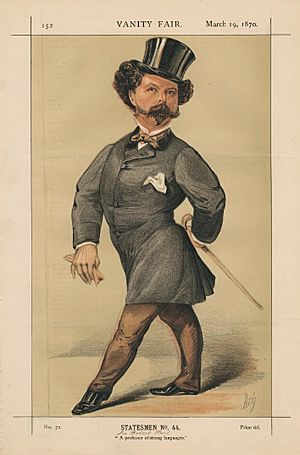Sir Robert Peel, 3rd Baronet facts for kids
Quick facts for kids
Sir Robert Peel
|
|
|---|---|

Sir Robert Peel, Bt, by Camille Silvy.
|
|
| Chief Secretary for Ireland | |
| In office 29 July 1861 – 7 December 1865 |
|
| Monarch | Victoria |
| Prime Minister | The Viscount Palmerston |
| Preceded by | Edward Cardwell |
| Succeeded by | Chichester Fortescue |
| Personal details | |
| Born | 4 May 1822 London |
| Died | 9 May 1895 (aged 73) Stratton Street, London |
| Nationality | English |
| Political party | Peelite Liberal |
| Spouses | Lady Emily Hay (1836–1924) |
| Alma mater | Christ Church, Oxford |
Sir Robert Peel, 3rd Baronet (born May 4, 1822 – died May 9, 1895) was a British politician. He was a Member of Parliament (MP) for many years. His father, also named Robert Peel, was a famous Prime Minister.
Sir Robert Peel was known for changing his political party. He started as a Peelite, then became a Liberal, and later a Conservative. He also served as the Chief Secretary for Ireland, helping to manage Irish affairs for the British government.
Contents
Early Life and School
Sir Robert Peel was born in London on May 4, 1822. He was the oldest son of Sir Robert Peel, 2nd Baronet, who was a very important statesman. His mother was Julia Floyd.
He went to Harrow School starting in February 1835. After Harrow, he attended Christ Church, Oxford university in 1841. However, he did not finish his degree there.
Working as a Diplomat
In 1844, Robert Peel began a career in the Diplomatic Service. This meant he worked for the British government in other countries. His first job was in Madrid, Spain.
In 1846, he was promoted to a higher role in Switzerland. He even served as the main diplomat, called chargé d'affaires, for a short time. When his father passed away in 1850, Robert became the 3rd Baronet. He then left his job in Switzerland.
His Time in Politics
After leaving the diplomatic service, Robert Peel became a Member of Parliament (MP). He represented the area of Tamworth from 1850 to 1880. This was the same area his father had represented.
He was a talented speaker with a strong voice and a good way with words. People thought he could become a very successful politician. However, he often changed his mind and did not always stick to one political belief. This made it hard for others to fully trust him.
Joining the Admiralty
In 1855, Lord Palmerston appointed him to a role in the Admiralty. This was a department that managed the navy. From this point on, he was seen as a Liberal politician. He strongly supported Italy's independence, which fit with Liberal ideas.
Trip to Russia and Ireland Role
In 1856, he went to Russia as a secretary for a special mission. He attended the coronation of Alexander II. However, he later gave a speech where he spoke badly about the Russian court. This caused problems and was even discussed in Parliament.
Despite this, in 1861, Lord Palmerston made him Chief Secretary for Ireland. This was a very important job. He tried to understand the Irish people by traveling around the country. He gave hopeful speeches about Ireland. However, problems like fenianism (an Irish nationalist movement) grew worse during his time there. His speeches in Parliament sometimes caused more arguments instead of peace.
When the Liberal government changed after Lord Palmerston died, Robert Peel lost his job. He did not hold a government position again. In 1866, he received a special honor, becoming a G.C.B..
Later Political Changes
He continued to be an MP for Tamworth as a Liberal. But he often disagreed with the policies of William Gladstone, another important Liberal leader. In 1874, he started calling himself a "Liberal-Conservative" again.
He did not run for Tamworth in the 1880 election. Instead, he tried to win a seat in Gravesend as a Conservative, but he was not successful. He often spoke at Conservative meetings, criticizing the Liberal government's actions.
In 1884, he was elected as a Conservative MP for Huntingdon. Then, in 1885, he became the MP for Blackburn.
In 1886, he chose not to vote on an important bill about Home Rule for Ireland. Later that year, he ran for the Liberal party again in Scotland, supporting Home Rule, but he lost. He also ran for Parliament in Brighton in 1889, again supporting Irish Home Rule. He did not win that election either and decided not to run for MP again.
Later Years
In his later life, Sir Robert Peel sold his father's valuable art collection to the National Gallery in 1871. He owned a lot of land across different parts of England. However, he faced personal challenges and stopped living at his family home, Drayton Manor.
Sir Robert Peel passed away on May 9, 1895, at the age of 73. He was found in his home in London. He was buried at Drayton Bassett's Anglican church. His son, also named Robert, became the next Baronet.
Family Life
Sir Robert Peel married Lady Emily Hay in 1856. She was the daughter of George Hay, 8th Marquess of Tweeddale.
They had five children: twin daughters Gwendolin Cecilia and Agnes Helen (born 1860), Victoria Alexandrina Julia (born 1865), Robert (born 1867), and Evelyn Emily (born 1869). Lady Emily Peel lived until 1924.


